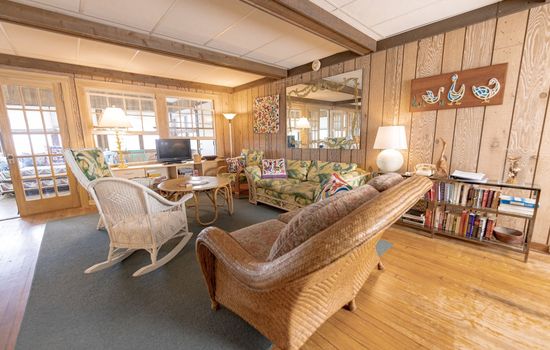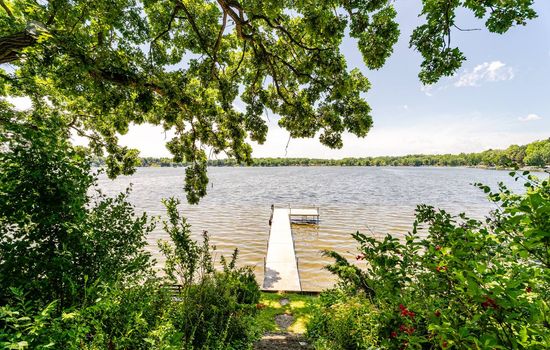The visitor center at Chicago Portage National Historic Site is open every day from sunrise to sunset, year-round.
There is no entrance fee at the Chicago Portage National Historic Site. Admission is free.
From downtown Chicago, take I-55 southwest, exit at Harlem Avenue, and head north for two blocks to arrive at this historic nexus where French explorers once traversed, linking the Great Lakes to the Mississippi River.
Parking lot holds about 40 cars, no RVs or overnight parking, free admission. Located on the west side of Harlem Avenue, just north of the Stevenson Expressway. No parking fees. Motorcycles welcome.
Accessibility & permits
Emergency
- Cell service availability:Full
Information not accurate?
Help us improve by making a suggestion.
Tucked away in the heart of Illinois, the Chicago Portage National Historic Site is a verdant oasis that seamlessly blends historical significance with natural beauty. Located at the junction of Portage Creek and the Des Plaines River, this 91.2-acre site marks the western end of the historic portage that once linked the Great Lakes to the Mississippi River, a pathway that played a pivotal role in the discovery and settlement of Chicago.
As you step into this preserved wilderness, you are enveloped by an array of ecosystems: open water marshes, floodplain forests, woodlands, and savannahs. The air is alive with the sounds of wildlife, including beavers, otters, and owls, while ancient oak trees stand sentinel, their gnarled branches a testament to the passage of time.
Hike along the trails that wind through the site, passing by interpretive signs and a memorial statue that honors the French explorers Louis Jolliet and Father Jacques Marquette, who were guided by the Kaskaskia tribe through this ancient portage. The landscape evolves with the seasons: spring brings a tapestry of native wildflowers, summer is marked by the warmth of prescribed burns that rejuvenate the habitat, and autumn paints the trees in vibrant hues.
While the site itself does not feature a lake, its proximity to the Des Plaines River and the Chicago River system makes it a haven for those interested in waterways. Nearby, the town of Lyons offers a charming backdrop with local eateries and shops. For the more adventurous, local outfitters provide opportunities for canoeing and kayaking along the rivers.
Throughout the year, visitors can participate in various events, including guided nature walks and educational programs led by park rangers. The site’s stewardship efforts, which include the removal of invasive species and native plant enhancements, ensure that this historic and natural treasure remains vibrant and untouched.
- Area (mi²)
- 1
- Annual visitors
- 600 000
- Established year
- 1952
Top 3 Facts about Chicago Portage National Historic Site
The site retains an open water marsh, floodplain forest, woodland, and savanna, with stewardship focused on removing invasive species and using prescribed burning to enhance native plant habitats over 36.9 hectares.
This historic site is a tapestry of diverse ecosystems, featuring open water marshes, floodplain forests, woodlands, and savannas. Ancient oak trees stand tall, while native plant communities thrive thanks to careful stewardship. The area is home to beavers, otters, owls, deer, elk, and black bears. Prescribed burning and invasive species removal ensure the survival of native flora, creating a habitat for a rich array of wildlife, making it a must-visit for nature enthusiasts.
At the confluence of Portage Creek and the Des Plaines River, the water’s gentle flow creates a serene backdrop, with the creek’s clear waters reflecting the lush greenery of the surrounding forest. The area’s flat terrain, a stark contrast to the rugged landscapes of other historic sites, highlights the strategic importance of this ancient portage, which once connected the Great Lakes to the Mississippi River. Here, visitors can walk trails that crisscross 91.2 acres of preserved wilderness, immersing themselves in a piece of America’s rich exploratory history.
Family programs
- Junior Ranger
- Ranger-led Tours
- Self-guided Tours
- Workshops & Hands-on Activities
- Living History & Cultural Demos
- Scavenger Hunts
- Arts & Crafts
Travel Tips
Plan Ahead
Visit in autumn for the fall colors. Plan a few days to explore trails and historic sites. Park at the designated lot, spend time at the visitors center, and anticipate unpaved trails. Bring meals and rest often. Enjoy cross-country skiing in winter or birding in spring.
Pack Appropriately
Pack layers for variable spring temperatures, ranging from 44°F to 82°F. Bring waterproof gear, sturdy shoes, and camping equipment if staying overnight. Check the forecast for specific days to ensure preparedness.
Respect Wildlife
Respect native habitats by staying on trails, avoiding invasive species spread, and not disturbing wildlife. Wear appropriate gear for seasonal weather and leave no trace to preserve this historic ecosystem.
Stay Informed
Stay on marked trails, avoid ledges and water edges, and check weather conditions and park alerts. For emergencies, call 911 or park authorities. Exercise caution and respect natural hazards.
Seasons
Visit in spring as temperatures rise to the 60s and 70s, with mild weather and blooming native plants. Attend Chicago Portage Day in September, though spring offers serene trails and historic interpretations amid vibrant flora. Ideal for outdoor enthusiasts and history buffs.
Visit in summer for warm temperatures (70s-80s°F) and sunny days. Attend Chicago Portage Day in September for storytelling, tours, and cultural exhibits, immersing yourself in historic significance and outdoor activities. Ideal for outdoorsy enthusiasts.
Visit in fall for crisp temperatures (40s-60s°F) and vibrant foliage. Attend Chicago Portage Day in September, featuring presentations, demonstrations, and site tours. Enjoy mild weather and rich cultural heritage. Ideal for a historic and immersive autumn experience.
Visit in winter from December to March, with temperatures ranging from 17°F to 38°F. Crisp air, potential snow, and fewer crowds make for a serene, historic immersion, though cold weather may limit outdoor activities.
Information not accurate?
Help us improve by making a suggestion.
Where to stay
Frequently Asked Questions
Ready to dive into what Chicago Portage National Historic Site has to offer? Let’s tackle some of the burning questions you might have as you plan your visit!
-
The closest city to the site is Chicago, which is about 12 miles northeast. The site is located in Lyons, Illinois, within the Portage Woods Forest Preserve and Ottawa Trail Woods Forest Preserve.
-
Dogs must be on a leash at the Chicago Portage National Historic Site. The leash should not be longer than 6 feet, and dogs should never be left unattended. Only leashed dogs are allowed on the trails and other areas of the site.
-
Parking is free at this site. There is a parking lot that can hold about 40 cars. No fees are mentioned for parking or entry.
-
The Chicago Portage was a crucial link between the Great Lakes and the Mississippi River, first used by Native Americans and later by French explorers Father Marquette and Louis Joliet in 1673. This portage route facilitated travel and trade, significantly influencing the development of the city of Chicago and the Midwest region. It became a key transportation link with the opening of the Illinois and Michigan Canal in 1848, spurring city development.
-
Mark your calendar for August 16-17, 2025 for the Chicago Air and Water Show. The rehearsal takes place on Friday, August 15 with the main events on Saturday and Sunday between 10:30 am and 3:00 pm each day. The prime viewing corridor stretches along the lakefront from Fullerton to Oak Street, with North Avenue Beach as the focal point, a perfect amphitheater where Chicago’s iconic skyline provides a stunning backdrop to aerial choreography.








